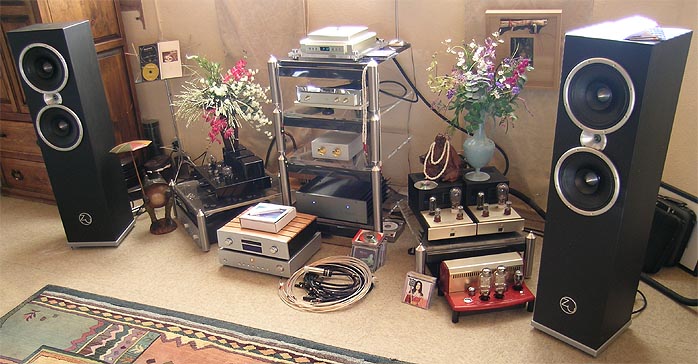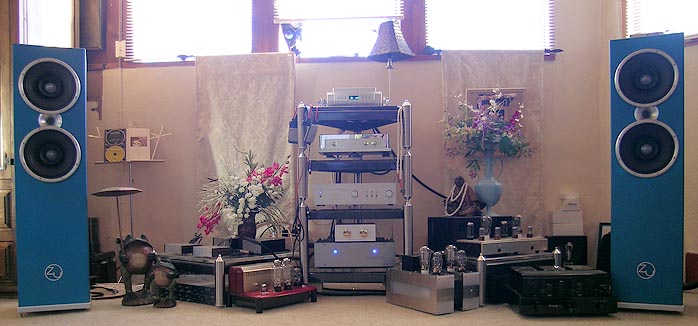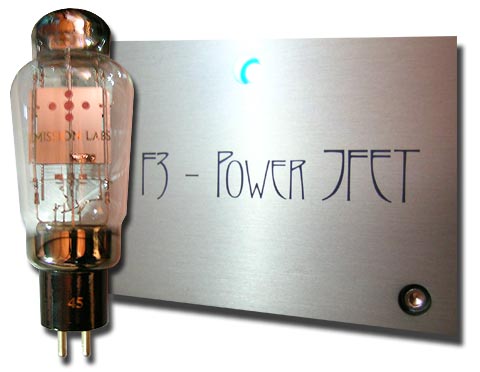|
This review page is supported in part by the sponsor whose ad is displayed above
|
|||||||||||||
 |
|||||||||||||
| Asked Danish solder jock Skorpio on the DIYPass forum: "Anybody tried to cascode the MOSFET in the ZEN amp? Something like the Power JFET amplifier, this will reduce the miller C but perhaps the main problem is Ciss." To which Mr. Pass -- the one and only as his byline there goes -- replied: "It works fine and that was the original circuit for the F3 last year. I still have it laying around, the performance is not as good as the JFET but it's still better than the Zens." So if that brief insider repartée wasn't Greek to you, that's how to build yourself an F3 that's not as good as the production version. Why bother? Well, that's the thing about DIY; the satisfaction of having done something with your own two hands. For those of us not so inclined -- or skilled -- there's the real F3. Coming off the 2-watt Yamamoto Soundcraft A-08S single-ended 45 amp with solid-plate Emission Labs bottles (which provides essentially equivalent gain to the FirstWatt amp), I was initially hard pressed to hear much of a difference. Sure, the sand amp did more bass and had more leading edge definition in the critical midbass region but where it matters to a tube hound -- midrange conviction and treble elegance -- the JFET amp did not telegraph its religion in any immediately obvious way. In fact, I was in no hurry to go back to my 45s. Had Nelson finally fashioned the transistor amp to make the thermionic crowd cry uncle? That would really be news. Before I signed my name on that ballot, I had to be sure beyond a quick casual impression. So began many listening sessions without comparisons, just to see whether sooner or later, certain defects or lacks would surface to reassure me that tubes still ruled. Hey, our kind ain't going down without a fight. Here's what I was listening for in isolation, i.e. without the benefit of A/Bs. That allows you to forget the old sound and deal with the new, period. Let that settle in. Let it persuade you (or not) on its own terms.
Needless to say, all of these qualities tie together. Some are simply different aspects of the same coin. Going down my list of what I think of as recognizable transistor traits, I didn't come across anything that went against my tubular grain. I heard no coldness, flatness, zing, whitishness, leanness or bass brutality. Neither was the amp dark, warm or hooded. It did sound extremely pure, with that ultra-refined ravishing elegance that has you reach for some nifty French expression -- savoirfaire perhaps -- to underline. Yet it did not display that peculiar crystalline coldness that turns aloofness. No frosty perfection of limitless detail as though you were watching deep space from orbit, silently longing for the shire with its sunlight and green. Certain Class D amps I've heard come from that place of inhuman perfection. It's ultimately not compelling or involving. Not so with this Power JFET amp. It's as compelling as a slushy cold drink on a hot day or a scalding-hot cider on a frost-bitten day of miserableness. |
|||||||||||||
 |
|||||||||||||
|
|
|||||||||||||
 |
With the 47Lab Gaincard just recently departed, I can tell you that the F3 made the music more intense by comparison. The Gaincard's calling card was a textural softness coupled to a relaxed mien. At this stage of my investigation, I couldn't yet identify the Power JFET's signature trait. I already knew that I could crank the crap out of it and nothing would harden up, get edgy or bare its fangs. This would be especially noticeable and objectionable in the presence region where my Pateks become occasionally a bit frisky. Time for a direct A/B against my AudioSector 50wpc Gainclone and my Yamamoto A-08S with its 2wpc of ultra-modern, highly linear 45 juice with tube rectification and zero NFB. |
||||||||||||
| What I expected were minor remaining differences of the kind best described as the tête-à-tête gap between vanilla and French vanilla ice cream - subtle hues of different flavor that clearly belong to the same school, taste or house sound. And that's exactly what I got. Surprisingly, the Yamamoto was just a touch more lit up in the presence region. The F3 -- not surprisingly -- had a slight edge in transient midbass impact. In either case, the differences weren't at all pronounced and merely minor shifts in perspective. The 45s as implemented by Shigeki-San are tone monsters and in the arena of timbre, arguably more saturated without affecting speed or transients. I half expected that given my tube proclivities. After all, tone is what our kind is after. What surprised the hell out of me? Going back to the Power JFET amp only took a few moments of listening to "recalibrate". This suggests to me that while identifiable in a direct A/B (such as only reviewers or on-the-spot shoppers conduct), the harmonic content of either amp is very similarly packed. That messed with my head. Yes, the valves still reigned supreme but this sand amp was far far closer than I would have conceived possible without Audiopax-style TimbreLocks. And we're not talking chocolate syrup or old Rowland-style darkness. None of that. This harmonic JFET finesse is for real, not a mirage of midrange focus created by shelving down treble energy. The Yamamoto isn't a lush but highly resolved and fast amp that simply avoids going lean, bright and edgy while retaining the vital ability to bite when a sax player squeals, a trumpet pierces or a plucked string sizzles. Ditto for the F3. Its ability to properly render a transient edge without softening but simultaneously, also without sounding edgy, brutal, hyped, forced or unnatural, is real trick. It means precision without mechanicalness, rhythm without drag or pushiness, music with life and energy but no artificial heightening. All of the above is true and factual. Yet comparing the words to actually listening to the JFET amp still has the descriptions fall well short. For one, the First Watt amp doesn't prematurely clip decays as most solid-state seems inclined to do. That's a vital ingredient to its tube-like sense of textural softness that coexists with the leading-edge jump factor we expect from solid-state. In that regard -- delivering both the transient speed and the leisurely ringing out of tones -- the F3 is perfectly centered between the banks of the river. If you subtract the overly enhanced quality of harmonics most non-feedback single-ended triode amps contribute, it's no stretch to call the Power JFET uncannily single-ended and tubular. The key words I keep coming back to are emotional purity and textural sophistication. The analog switching amps by NuForce had massive purity too but -- at least for me -- they rather lacked the emotional connection or persuasiveness to be a bit flat and cold in that very subjective dimension. They tilted the axis in favor of detail and away from a holistic sense. The F3 is purity incarnate but connects just as powerfully as a superior -- read linear low-distortion -- valve amp. It doesn't sound exactly the same but it's perhaps the closest non-glass amp yet to a modern, wide bandwidth valve amp like the Yamamoto. More importantly and without any doubt on my part whatsoever (I'm signing this ballot with my reputation on the dotted line), it nails the same gestalt, the same feel or vibe. Compared to my Pateks, those have more bite in the presence region, a bit more image density and color temperature pop across the board and just a tad more emphasis on the front (the beginning of the notes) as though the F3 elongated the fades a bit more. The Pateks, most likely because of their power advantage, also have more raw low-bass amplitude. The Power JFET is more suave and "organic". If I had to pick one, the final nod would go to the Pass amp. Fortunately, I don't have to pick. With the Pateks doing monaural duty on the bass array of my Definitions, the F3 will become my new Yammy stand-in for those days when French Vanilla gets old and regular Vanilla is called for. Not letting this particular F3 return to California also means I will own a machine that was still hand-assembled by the master. Common sense dictates that if this amp becomes the runaway success it deserves to turn into, admiral Nelson will sooner than later have to rely on ship hands to help with assembly. Seeing that audio is as much art as it is science, owning an affordable masterpiece handcrafted by the man himself exudes an irresistible lure that I shall cherish as part of my growing audio toy collection well beyond the machine's simply superb sonic performance. |
|||||||||||||
 |
|||||||||||||
Power JFET = Powerful Justification For Eliminating Triodes I knew the day would come. I just didn't know Nelson Pass would be the one to usher it in. My bet was on Eduardo de Lima whose new $11,990/pr Model 55 30-watt monos (my mystery amps hinted at a long time ago as solid-state amps sounding better than the Audiopax Model 88 valve equivalents) might well be next in line to vanquish my insistence on valves - again. But the F3 got to me first. As it stands, the only glowing thingies outside of LEDs in the rig during the main review period were the 7308 dual triode in the Zanden DAC and the valves in its power supply section. There's nothing that now in the wake of the review compels me to reinsert the Yamamoto. |
|||||||||||||
 |
|||||||||||||
I will reinsert it, make no mistake -- and thereafter the F3 for a game of endless musical chairs -- but if some alteration in the Constitution suddenly outlawed triodes, my musical beat wouldn't stall for even a single second. That's how good these junction field effect transistors as output devices really are. With hand on heart, I didn't discover the following quote until today: "The sound is absolutely extraordinary. The F3 is by far the best single-stage audio power amplifier on the planet, a testament to the potential of power JFET transistors. Until other designers catch on, it will also be the only commercially available power JFET amplifier on the market. - Nelson Pass" |
|||||||||||||
| We've all become so inured to hyperbolic press releases and designer ego that such statements by actual creators are fully expected to be - um, buffed up to the nth degree. I don't know about other single-stage audio amps on the planet but I do know that the F3 is truly extraordinary just as its designer gushes (quite out of character really). Sure, the modest power output still means its appeal is restricted. But at 15wpc into 8 ohms, it's on par with paralleled single-ended 300B or KT88 amps or regular 845 SETs. And seeing how many of those exist (and how there is zero present competition for the F3), the potential for this amp to "make the rounds" should be quite attractive to a kitchen table effort. Add a price that's lower than any similarly powered tube SET and eliminate tube aging, bias drift and tube rush/noise. What we have here then is not only the best F- | |||||||||||||
 |
|||||||||||||
| Series First Watt amp yet but also the most universal one of the bunch (30wpc Aleph J excepted but that's not really part of the F family). The Power JFET amp is definitive and completely unambiguous award material. It demonstrates how circuit simplicity, application ingenuity and novel hi-tech devices can meet to advance the art and erase even further those remaining dividing lines between hollow and solid state. In short, the F3 is a transistor amp that should appeal to all lovers of glowing glass and allow those who can't go there (because of heat, kids, pets, expense, impedance issues, reliability issues) to enjoy its sound without the liabilities. As you've undoubtedly noticed, I've attempted to describe what this amp sounds like nearly exclusively by what it doesn't do. I've approached this assignment unapologetically from the "tube guy criticizes transistors" angle. The fact that I found nothing to complain about should -- in my book at least -- be the core impression you take away. Consider me very much and very pleasantly surprised, educated, enlightened and rebiased. This assignment literally turned out to be about "something truly different now." The F3 Power JFET amp advances the state of the art in low-power triode-like solid-state amps for high-efficiency speakers to the next level. And while he insists that his objective wasn't to clone tubes, I believe that in this instance, the gentleman protesteth too much. That's why Mr. Pass' legendary status as America's foremost transistor amp designer remains unchallenged still. | |||||||||||||
 |
|||||||||||||
 |
|||||||||||||
 |
|||||||||||||
|
Manufacturer's website
|
|||||||||||||
 |
|||||||||||||